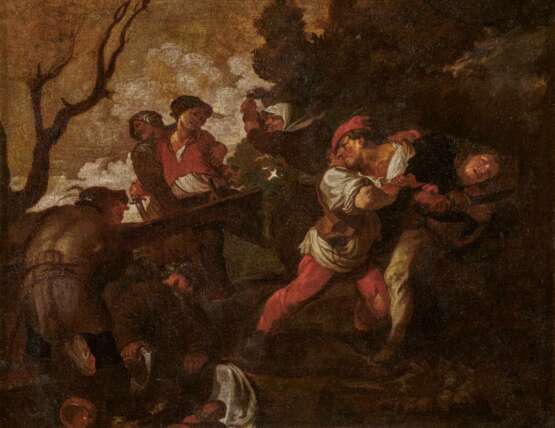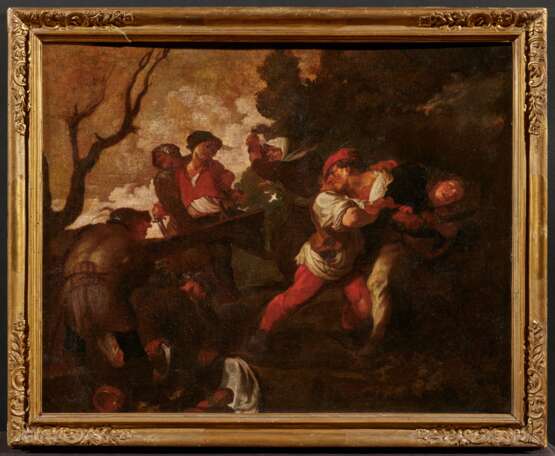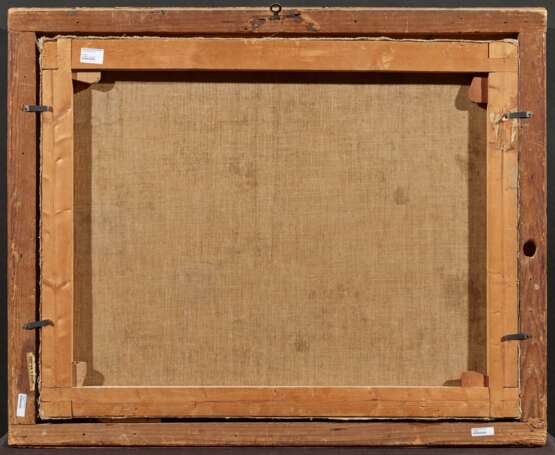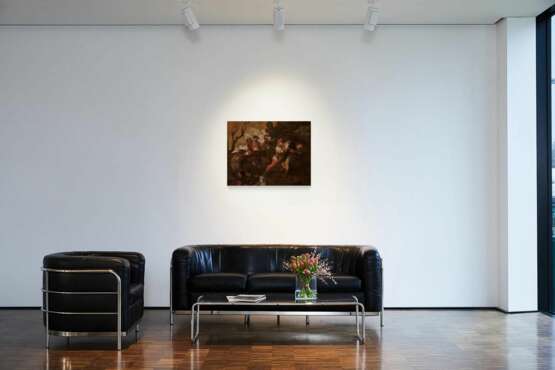ID 1208007
Lot 1012 | Johann Liss. Scuffling Farmers
Estimate value
€ 40 000 – 80 000
um 1597 Oldenburg - 1631 Verona
Title: Scuffling Farmers.
Date: Ca. 1620.
Technique: Oil on canvas.
Mounting: Relined.
Measurement: 66,5 x 84cm.
Frame: Framed.
Certficate:
Alberto Cottino, Turin, 21 December 2020, copy available.
Provenance:
Private ownership, Italy.
The present painting, with its extremely dynamic composition and strong narrative character, has been in an Italian collection for several decades. A man with a red cap and drawn sword can be seen in the foreground, who is being held back with difficulty by two other men, presumably compatriots, because he apparently wants to pounce on the young man in the background. The latter is also being placated by a woman, while another, on the right, appears to be attacking him. Some figures in the foreground on the left are moving away anxiously; the crockery has fallen to the floor.
There are two other versions with this theme, both attributed to Johann Liss. One, in Alberto Cottino's opinion of excellent quality but slightly cut off at the right and lower edge, is in the Germanisches Nationalmuseum in Nuremberg; the other, of harsher and more schematic execution, is in the Tiroler Landesmuseum Ferdinandeum in Innsbruck.
According to Alberto Cottino, the painting on offer is of similar quality to the Nuremberg painting and of better quality than the Innsbruck painting; it also has some not insignificant variations (for example, the tree on the far right is missing in our version, the section of sky in the background on the right does not appear in the Nuremberg painting, the earthenware pots in the foreground, which can only be seen in the German version) and a number of pentimenti that can be seen in the reflectograms, particularly in the buckle of the figure at the back left, in the foliage of the trees, in the legs and thighs of the main figure and in the distance of a stone between the feet of the same figure.
These are all elements that qualify the painting offered here as an independent and autograph version of the German canvas, to be judged as entirely by Liss (the Innsbruck painting is clearly an early copy, as Richard Spear also believes in 1976).
The subject seems to be a brawl between card players, which takes place after a long drink, as the jugs on the floor and the overturned bench suggest.
It is a theme that was of particular importance in Nordic, Protestant-influenced painting, which often dealt with human debauchery, such as gambling, alcohol and uncontrolled urges, especially of the lower classes, and their moral condemnation in the picture. In fact, as Rüdiger Klessmann suggested in the 1975 exhibition catalogue, the inspiration in this case could have come from an engraving by the German painter Hans Sebald Beham (1500-1550) from 1547, which depicts a peasant brawl that Liss added his own invented details to.
According to his biographer Joachim von Sandrart (1606-1688), who knew him personally, Liss came from Oldenburg in Holstein. His parents, Johann and Anna, are documented as painters at the Schleswig court of the Dukes of Holstein, and it was probably there that he received his early training before embarking on the journey to the Netherlands around 1615, which was customary for young German artists. According to Sandrart, Liss stayed in Amsterdam between 1615 and 1616, where he studied the style of the artist Hendrick Goltzius (1558-1616/17) and was inspired by him. From there, the young painter probably travelled to Antwerp around 1617-18, where he looked at the works of Rubens, Jordaens and Abraham Janssens, which were to have a profound influence on his art, before going to Rome and Venice. Here Liss adopted an Italianate style, influenced first by Caravaggio and then by Domenico Fetti, which differs markedly from the style expressed in the works analysed here. Liss died in Verona during the plague of 1630-1631.
Since no trace of Italianism can be recognised in the work examined here, not even in the particularity of the subject, which is alien to Italian culture, it must, contrary to Spear's opinion, have been created in Holland or Flanders and then brought to Italy (the Innsbruck version was in fact made in Venice). It follows from this that - like the painting in Nuremberg - it must have been created between 1616 and 1619. Moreover, as there are no specific references to Rubens, Jordaens or Janssens, it is perhaps even more obvious to narrow it down to the years 1616-17, i.e. before the journey to Antwerp.
| Artist: | Johann Liss (1597 - 1631) |
|---|---|
| Applied technique: | Oil |
| Auction house category: | Old Masters |
| Artist: | Johann Liss (1597 - 1631) |
|---|---|
| Applied technique: | Oil |
| Auction house category: | Old Masters |
| Address of auction |
VAN HAM Kunstauktionen GmbH Hitzelerstr. 2 50968 Köln Germany | ||||||||||||||
|---|---|---|---|---|---|---|---|---|---|---|---|---|---|---|---|
| Preview | |||||||||||||||
| Phone | +49 221 92586215 | ||||||||||||||
| Fax | +49 221 92 58 62 4 | ||||||||||||||
| Buyer Premium | 32% | ||||||||||||||
| Conditions of purchase | Conditions of purchase | ||||||||||||||
| Business hours | Business hours
|








